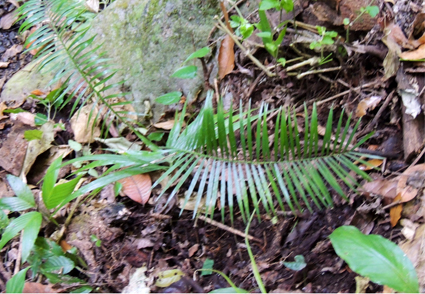Abstract
Chamaedorea tacanensis (Arecaceae), a new species from the Tacaná Volcano Biosphere Reserve, Chiapas, Mexico, is described based on morphological and phylogenetic data. It is morphologically similar to C. elatior, the only other climbing species in the genus. However, C. tacanensis is distinguished by having linear pinnae (lanceolate in C. elatior), petioles emerging glaucous (glabrous in C. elatior), and longer rachises, blades and peduncles than C. elatior. Also, C. tacanensis has pinnate-leaved seedlings and juveniles, whereas they are simple or bifid in C. elatior. The two taxa form separate monophyletic groups. Geographically, C. tacanensis is found in tropical montane cloud forests of the Pacific slope whereas C. elatior mostly occurs in lowland tropical forests of the Atlantic slope. Chamaedorea tacanensis has been recorded in only three localities: two in the Tacaná Volcano Biosphere Reserve, Mexico, and one in San Marcos, Guatemala. Further floristic studies in surrounding areas might better clarify the geographic distribution range of this species.
References
<p>Cano, A. (2018) <em>What Can Palm Evolution in Time and Space Say About the Historical Assembly of Diversity in the Caribbean and Central America? </em>PhD. Thesis No. 5180. University of Geneva, Faculty of Sciences, 296 pp.</p>
<p>Capella-Gutiérrez, S., Silla-Martínez, J.M. & Gabaldón, T. (2009) trimAl: a tool for automated alignment trimming in large-scale phylogenetic analyses. <em>Bioinformatics</em> 25: 1972–1973. https://doi.org/10.1093/bioinformatics/btp348</p>
<p>Challenger, A., Golicher, D., González-Espinoza, M., March-Mifsut, I., Ramírez-Marcial, N. & Vidal-Rodríguez, R.M. (2010) <em>Sierras del sur de Chiapas</em>. <em>In:</em> CONABIO. <em>El Bosque mesófilo de montaña en México: amenazas y oportunidades para su conservación y manejo sostenible, Comisión Nacional para la Conservación y Uso de la Biodiversidad.</em> Mexico City, Mexico, pp. 124–131.</p>
<p>Cuenca, A. & Asmussen-Lange, C.B. (2007) Phylogeny of the palm tribe Chamaedoreeae (Arecaceae) based on plastid DNA sequences. <em>Systematic Botany.</em> 32: 250–263.</p>
<p>Cuenca, A., Dransfield, J.B. & Asmussen-Lange, C.B. (2009) Phylogeny and evolution of morphological characters in tribe Chamaedoreeae (Arecaceae). <em>Taxon</em> 58: 1092–1110. https://doi.org/10.1002/tax.584004</p>
<p>Donoghue, M.J. (1985) A critique of the biological species concept and recommendations for a phylogenetic alternative. <em>Bryologist</em> 88: 172–181. https://doi.org/10.2307/3243026</p>
<p>Dransfield, J., Uhl, N.W., Asmussen, C.B., Baker, W.J., Harley, M.M. & Lewis, C.E. (2008) <em>Genera Palmarum, The Evolution and Classification of Palms</em>. Kew Publishing, Royal Botanic Gardens, Kew, in association with the International Palm Society and the L.H. Bailey Hortorium, Cornell University, 732 pp.</p>
<p>Edgar, R.C. (2004) MUSCLE: multiple sequence alignment with high accuracy and high throughput. <em>Nucleic Acids Research </em>32: 1792–1797. https://doi.org/10.1093/nar/gkh340</p>
<p>GBIF (Global Biodiversity Information Facility) (2021) GBIF Occurrence Download. https://doi.org/10.15468/dl.kq8se2.</p>
<p>Henderson, A., Galeano, G. & Bernal, R. (1995) <em>Field Guide to the Palms of Americas</em>. Princeton University Press, Princeton, New Jersey, 352 pp.</p>
<p>Hodel, D.R. (1991) The cultivated species of <em>Chamaedorea</em> with cespitose habit and pinnate leaves. <em>Principes</em> 35: 184–198.</p>
<p>Hodel, D.R. (1992a) <em>Chamaedorea</em> <em>Palms. The Species and their Cultivation. </em>Allen Press, Lawrence, Kansas, 338 pp.</p>
<p>Hodel, D.R. (1992b) <em>Chamaedorea</em>: diverse species in diverse habitat. <em>Bulletin de l’Institut Français d’Études Andines</em> 21: 433–458.</p>
<p>Hodel, D.R. (1999) Problems interpreting variation in <em>Chamaedorea</em>. <em>In</em>: Henderson, A. & Borchsenius, F. (Eds.) <em>Evolution, Variation, and Classification of Palms</em>. <em>Memoirs of the New York Botanical Garden</em> 83: 185–189.</p>
<p>Hodel, D.R. (2013) <em>Chamaedorea</em> <em>Palms</em> 20 years after. <em>Palms</em> 57: 161–175.</p>
<p>Hodel, D.R. & Castillo Mont, J.J. (1995) An unusual simple-leaved form of <em>Chamaedorea elatior</em>. <em>Palm Journal </em>121: 27–33.</p>
<p>Martiìnez-Camilo, R., Martiìnez-Meleìndez, N., Martiìnez-Meleìndez, M., Peìrez-Farrera, M.A. & Jimeìnez-Loìpez, D.A. (2019) Why continue with floristic checklists in Mexico? The case of the Tacanaì-Boqueroìn Priority Terrestrial Region, in the Mexican State of Chiapas. <em>Botanical Sciences</em> 97: 741–753. https://doi.org/10.17129/botsci.2174</p>
<p>Martius, C.F.P.V. (1830) Drei neue mexicanische Palmen. <em>Linnaea</em> 5: 204–205.</p>
<p>Martius, C.F.P.V. (1849) Synopsis Palmarum. In systema receptarum, indicata simul patria et adjectis passim characteribus. <em>Historia Naturalis Palmarum</em> 3: 307–344.</p>
<p>Posada, D. (2008) jModelTest: phylogenetic model averaging. <em>Molecular Biology and Evolution</em> 25: 1253–1256. https://doi.org/10.1093/molbev/msn083</p>
<p>Quero, R.H.J. (1994) <em>Palmae. Flora de Veracruz</em>. Fasc. 81. pp. 1–118.</p>
<p>Regel, E. (1880) Beitrag zur Palmenflora Amerika’s von Hrm. Wendland. <em>Gartenflora</em> 29: 104–105.</p>
<p>Rzedowski, J. (2006) <em>Vegetación de México</em>. 1ra. Edición Digital, Comisión Nacional para el Conocimiento y Uso de la Biodiversidad, Mexico City. 504 pp.</p>
<p>Toledo, V.M. (1982) Pleistocene change of vegetation in tropical Mexico. <em>In</em>: Prance, G.T. (ed.) <em>The Model of Diversification in the Tropics</em>. Columbia University Press, pp. 93–111.</p>
<p>Toledo-Aceves, T., Meave, J.A., González-Espinoza, M. & Ramírez-Marcial, N. (2011) Tropical montane cloud forests: current threats and opportunities for their conservation and sustainable management in Mexico. <em>Journal of Environmental Management</em> 92: 974–981. https://doi.org/10.1016/j.jenvman.2010.11.007</p>
<p>Thomas, M.M., Garwood, N.C., Baker, W.J., Henderson, S.A., Russell, S.J., Hodel, D.R. & Bateman, R.M. (2006) Molecular phylogeny of the palm genus <em>Chamaedorea</em> based on the low-copy nuclear genes PRK and RPB2. <em>Molecular Phylogenetic and Evolution</em> 38: 398–415. https://doi.org/10.1016/j.ympev.2005.08.019</p>
<p>Wendland, H. (1854) <em>Index Palmarum, cyclanthearum, pandanearum, cycadearum, quae in hortis europaeis coluntur</em>. Hannover, 68 pp.</p>
<p>Willdenow, K.L. (1806) <em>Species Plantarum</em>. Editio quarta. Tomus IV. Pars II. Impensis G.C Nauk, Berlin, 1157 pp.</p>


